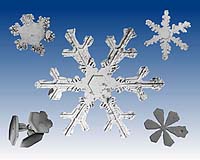| . |  |
. |
Freiburg, Germany (UPI) Jan 27, 2009 German scientists say they've developed a highly sensitive, miniaturized mobile ozone sensor that can operate in the air or water. The researchers at the Fraunhofer Institute for Applied Solid State Physics note ozone is a powerful oxidizing agent and can cause a wide range of symptoms in humans, including headaches, coughing and even deterioration in lung function. "Since ozone is, at the same time, an agent with high application potential, novel sensors are required, which have to be compact and affordable," Fraunhofer project manager Volker Cimalla said. "Sensors are essential equipment in industrial settings such as wastewater treatment facilities and water sterilization units, where they are used to monitor the ozone concentration -- firstly to ensure the required concentration for the relevant application is maintained, and secondly to guard against exceeding hazardous thresholds for humans." Cimalla said the newly developed sensor is capable of measuring low ozone levels that occur in environmental and ambient air monitoring just as accurately as the high levels associated with industrial process control. And, he added, since the sensor is extremely small, it can even be integrated into mobile equipment. The sensor's capabilities are detailed in the January issue of Fraunhofer Research News.
Share This Article With Planet Earth
Related Links All about the Ozone Layer
 Snowflake Chemistry Could Give Clues About Ozone Depletion
Snowflake Chemistry Could Give Clues About Ozone DepletionWest Lafayette IN (SPX) Dec 08, 2009 There is more to the snowflake than its ability to delight schoolchildren and snarl traffic. The structure of the frosty flakes also fascinate ice chemists like Purdue University's Travis Knepp, a doctoral candidate in analytical chemistry who studies the basics of snowflake structure to gain more insight into the dynamics of ground-level, or "tropospheric," ozone depletion in the Arctic. ... read more |
|
| The content herein, unless otherwise known to be public domain, are Copyright 1995-2009 - SpaceDaily. AFP and UPI Wire Stories are copyright Agence France-Presse and United Press International. ESA Portal Reports are copyright European Space Agency. All NASA sourced material is public domain. Additional copyrights may apply in whole or part to other bona fide parties. Advertising does not imply endorsement,agreement or approval of any opinions, statements or information provided by SpaceDaily on any Web page published or hosted by SpaceDaily. Privacy Statement |